Brazilian cuisine is a vibrant tapestry of flavors, reflecting the country’s rich cultural heritage and diverse culinary traditions. From hearty meat dishes to tropical fruits and savory snacks, Brazilian food offers a delightful range of tastes and textures.
There are many famous things in Brazil, and food is certainly one of them!
What Makes Brazilian Food Special?
Traditional Brazilian foods are an exquisite reflection of the country’s rich history, vibrant culture, and diverse culinary traditions. The uniqueness of Brazilian cuisine lies in its fusion of flavors and influences from indigenous communities, African heritage, European colonization, and the contributions of immigrants from around the world.
The roots of traditional Brazilian foods can be traced back to the indigenous peoples who cultivated native ingredients like cassava, corn, and various tropical fruits. These ingredients formed the foundation of Brazilian cuisine and continue to be prominent in its traditional dishes.
The Most Popular Meat-Based Food In Brazil
Feijoada (Black Bean And Beef Stew)
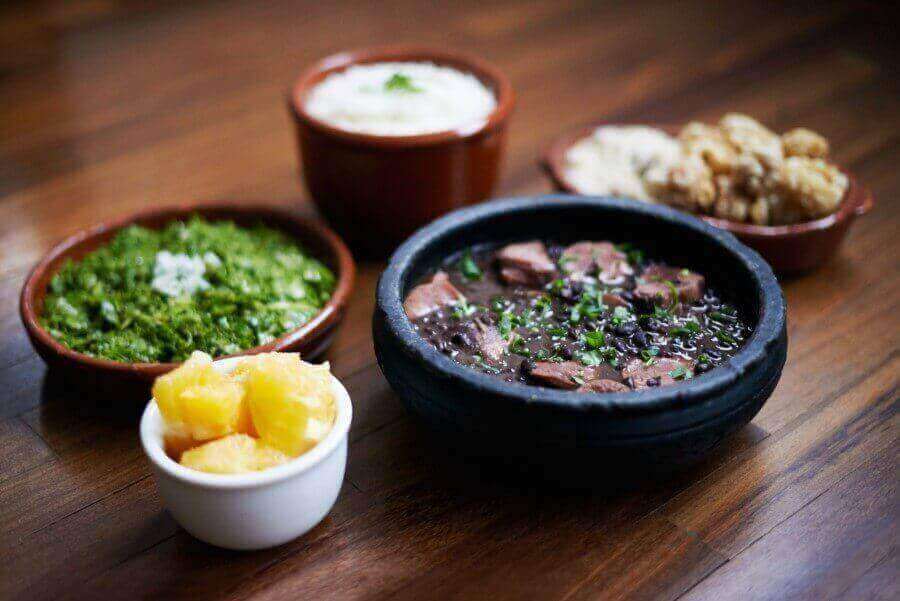
Feijoada is a beloved traditional Brazilian food that represents the rich culinary heritage of Brazil. Originating from Rio de Janeiro, this hearty black bean stew is a staple in Brazilian cuisine. Made with various cuts of pork, sausage, and spices, Feijoada is a flavorful dish that is typically served with rice, collard greens, and farofa.
This dish is a true reflection of the delicious and satisfying food in Brazil that is inspired by diverse cultural influences. It originated from the traditional Portuguese bean stew but has evolved over time with African and indigenous influences, making it an iconic part of Brazilian cuisine. Feijoada’s history dates back to the era of slavery, where it was originally prepared by enslaved Africans using affordable cuts of meat and beans.
Today, Feijoada is celebrated as a symbol of Brazilian culinary heritage and is enjoyed around the world as a representation of the delicious foods from Brazil.
Coxinha (Deep-Fried Chicken Bites)
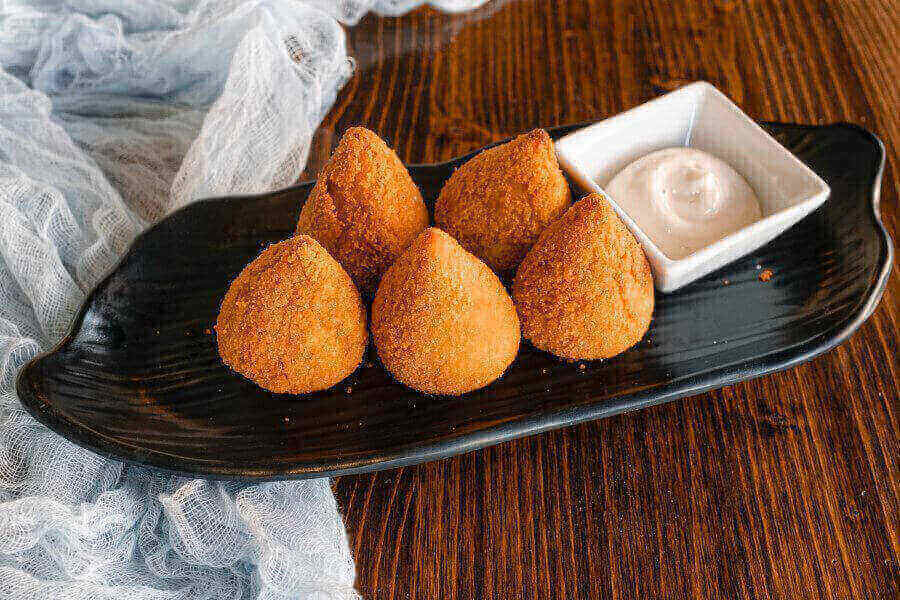
Coxinha, a traditional Brazilian food, showcases the rich culinary heritage and vibrant flavors of Brazilian cuisine.
Originating in São Paulo, this beloved snack is a testament to the diverse array of foods from Brazil. Coxinha features a delightful combination of shredded chicken enveloped in a dough crafted from wheat flour and potato, meticulously shaped into a drumstick-like form, breaded and deep-fried to achieve a golden and crispy exterior. Italian immigrants introduced these salty snacks to Brazil during the 19th century.
The distinctive shape of Coxinha, resembling a chicken drumstick, perfectly captures its name, “little thigh.” Today, Coxinha has evolved into an iconic Brazilian street food, celebrated as a delicious and convenient snack enjoyed by people of all ages.
Whether relished as a quick bite or as part of a larger feast, Coxinha serves as a delectable reminder of the diverse flavors and culinary prowess that define Brazilian BBQ and traditional Brazilian food.
Acarajé (Traditional Meat “Fritters”)
Acarajé, an iconic representation of traditional Brazilian food, showcases the vibrant tapestry of flavors found in Brazilian cuisine.
Hailing from the northeastern state of Bahia, this delectable street food has captivated the palates of locals and visitors alike. Acarajé is made by deep-frying a ball of black-eyed pea dough until it has a golden and crispy exterior. Then it is filled with a combination of shrimp, vatapá (a spicy paste comprising shrimp, peanuts, and coconut milk), and caruru (a savory sauce made from okra and palm oil).
Today, Acarajé stands proudly adorn the streets of Bahia, symbolizing the region’s vibrant culture and serving as a testament to the wealth of foods of Brazil.
Churrasco (Brazilian Grilled Steak)

Churrasco, an essential part of Brazilian cuisine and traditional Brazilian food, perfectly manifests the vibrant culinary culture of this country. This renowned Brazilian barbecue captures the essence of indulgence. A feast for the senses, churrasco involves skewering various cuts of meat, including beef, pork, and chicken, and grilling them over open flames to perfection.
The roots of churrasco can be traced back to the gaucho (cowboy) culture prevalent in the Southern region of Brazil. These skilled horsemen and cattle ranchers would gather around open fires, showcasing their expertise in grilling meat. Over time, this art of grilling spread across the country, solidifying its place as a symbol of Brazilian cuisine.
Beyond its delectable flavors, churrasco holds a deep social significance, uniting friends and family in the joyous celebration of a hearty meal.
Picanha (Traditional Grilled Sirloin)

Picanha, a celebrated and prized cut of beef in Brazilian cuisine, shows off the rich and flavorful tradition of food in Brazil. Renowned for its tenderness, juiciness, and exceptional taste, picanha is a cut that is grilled to perfection, yielding a delectable dining experience.
Served alongside traditional sides like farofa, rice, and beans, picanha is a staple dish that showcases the authentic flavors of Brazilian cuisine. Originating from the gaucho culture in the Southern region, where cattle ranching thrived, picanha gained prominence and became a favorite choice for grilling.
The term “picanha” specifically refers to the top sirloin cap, known for its succulent marbling and exceptional texture. Today, picanha stands as one of the most cherished and flavorful cuts of meat in Brazil, delighting diners in churrascarias and home barbecues across the country.
Cuscuz Paulista (Traditional Savory Couscous Pie)
Cuscuz Paulista, a savory culinary delight hailing from the state of São Paulo, exemplifies the fusion of Arab influences and the unique flavors of food in Brazil
This dish features couscous made from cornmeal, expertly combined with an array of vegetables, meats, and olives, resulting in a hearty and flavorful meal. Influenced by Arab culinary traditions, Cuscuz Paulista bears the name “cuscuz,” derived from the Arabic term “kuskus,” denoting a dish prepared from steamed grains.
With the arrival of Arab immigrants in Brazil, their techniques and ingredients, including couscous, were integrated into the local Brazilian food. In São Paulo, this dish underwent further evolution, incorporating local ingredients and flavors to create Cuscuz Paulista, a beloved choice for breakfast, lunch, or dinner.
Whether enjoyed as a comforting family meal or a festive feast, Cuscuz Paulista represents the culinary diversity and vibrancy of Brazilian cuisine.
Carne De Sol (Traditional Air-Dried Steak)
Carne de Sol, a cherished dish in Brazilian cuisine, showcases the ingenuity of traditional culinary practices. This delectable specialty revolves around sun-dried beef, meticulously prepared through seasoning, curing, and drying processes.
The result is a flavorful and slightly salty meat that can be grilled or fried to perfection. Carne de Sol traces its origins to the northeastern region of Brazil, where it emerged as a preservation technique in the absence of refrigeration. The name “carne de sol” translates to “sun-dried meat,” highlighting the traditional method of air-drying the beef under the sun’s rays.
The process of salting and drying not only imparts a distinctive taste but also imbues the meat with a unique texture, making it a sought-after ingredient in traditional northeastern cuisine. Carne de Sol exemplifies the art of transforming simple ingredients into culinary delights, embodying the essence of Brazilian cuisine and its rich tapestry of flavors.
Barreado (Tender Beef Stew)
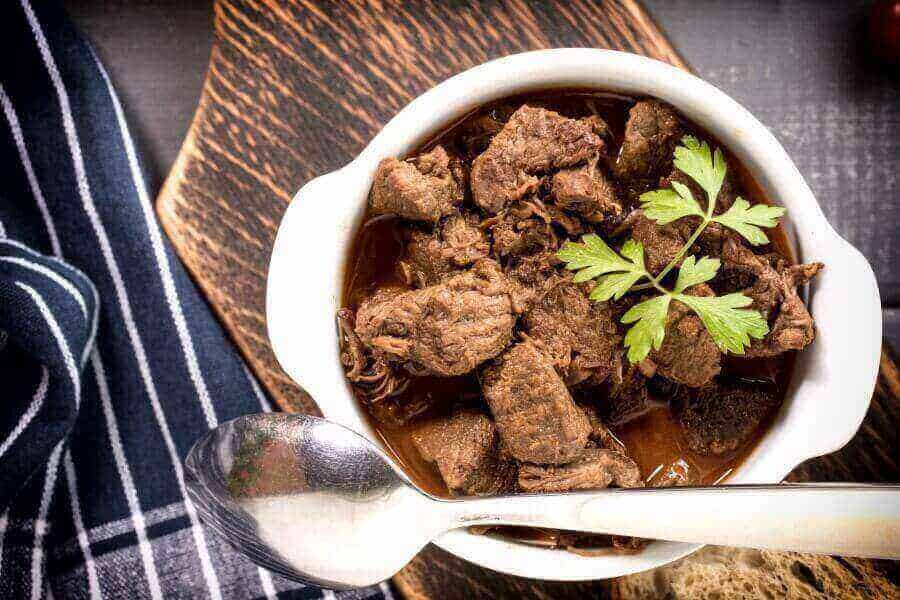
Barreado, a traditional Brazilian food hailing from the state of Paraná, exemplifies the rich culinary heritage and diverse flavors of Brazilian cuisine.
This slow-cooked beef stew is prepared with tender beef, savory bacon, onions, and a blend of spices, simmered to perfection in a sealed clay pot for several hours.
Barreado is traditionally accompanied by fragrant rice, crunchy farofa, and slices of banana, creating a harmonious combination of flavors and textures. The origins of Barreado can be traced back to the resourceful fishermen of Paraná, who devised this nourishing dish to sustain them during their demanding fishing expeditions.
The name “barreado” references the clay pot used for cooking, which is sealed with a paste made from flour and water to ensure the full retention of flavors and juices. Today, Barreado proudly represents the culinary heritage of Paraná, captivating palates with its tender meat and hearty essence.
Caldo Verde (Traditional Kale And Sausage Soup)

Caldo Verde is a beloved soup that has found its place in traditional Brazilian food.
This comforting soup features a combination of kale, potatoes, onions, and garlic, and often includes slices of smoked sausage. It has become quite popular among the different foods of Brazil, particularly during the colder months, as a warm and hearty option that satisfies the palate.
The dish’s introduction to Brazil by Portuguese settlers showcases the influence of European cuisine on the culinary traditions of the country. Caldo Verde’s vibrant green color, reflected in its name, adds to its appeal, enticing both locals and visitors to savor its nourishing broth and delightful flavors.
Pastel (Deep-Fried Brazilian Pastries)
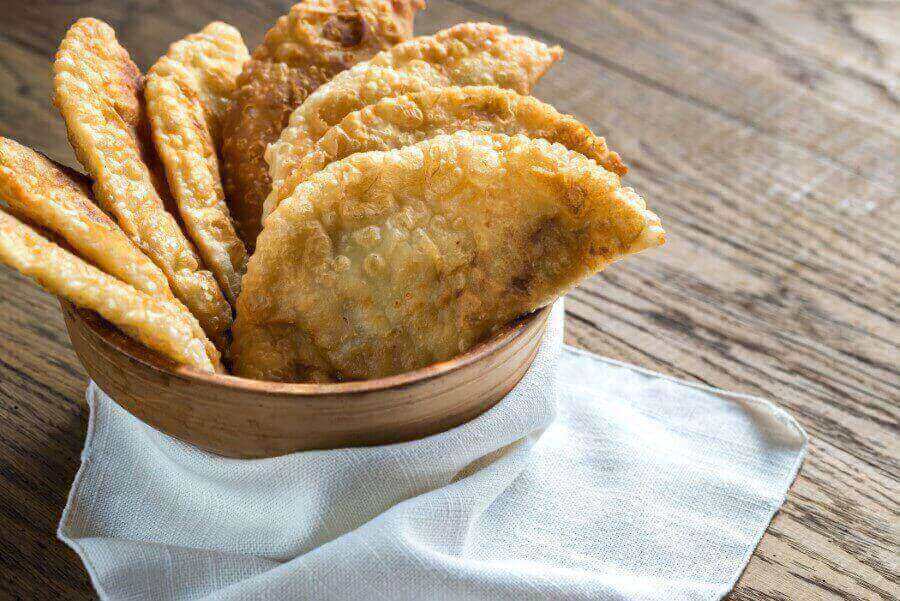
Pastel, a beloved street food in Brazil, is a testament to the diverse and flavorful foods from Brazilian cuisine. This popular snack features thin pastry dough filled with a variety of savory ingredients, including cheese, ground meat, chicken, and vegetables.
The filled dough is folded, sealed, and deep-fried until crispy, creating a delightful combination of textures and flavors. The origins of Pastels can be traced back to Chinese immigrants who brought their dumpling-making skills to Brazil in the early 20th century.
Through the fusion of Chinese techniques and local Brazilian ingredients, Pastels emerged as a unique and delicious street food that is enjoyed by people of all ages across the country. It’s one of the best Brazilian pastries you can try!
Arroz De Carreteiro (Traditional Rice Dish)
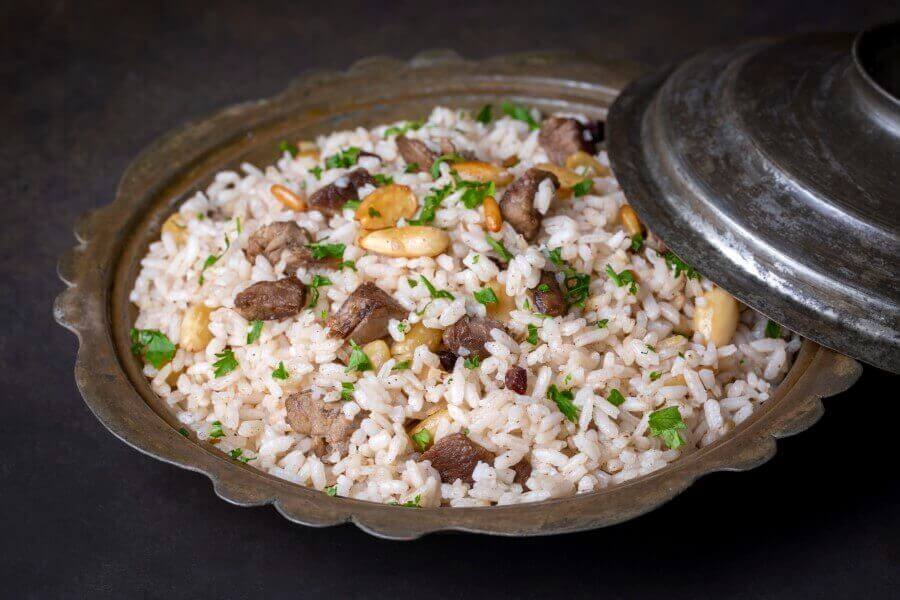
Arroz de Carreteiro, a traditional Brazilian rice dish, embodies the essence of traditional Brazilian food and showcases the rich culinary heritage of the southern region. This flavorful one-pot meal is made with rice, beef (often leftovers), onions, garlic, and spices.
Its origins can be traced back to the gaucho culture of the southern region, where cowboys known as gauchos relied on simple ingredients to create nourishing meals during their journeys. Arroz de Carreteiro represents resourcefulness and the ability to transform leftover ingredients into a delicious and satisfying dish.
Today, this food from Brazil is cherished for its robust flavors and connection to the gaucho traditions, offering a taste of the rustic and vibrant culinary spirit of southern Brazil.
Quibe (Deep-Fried Meat Snacks)
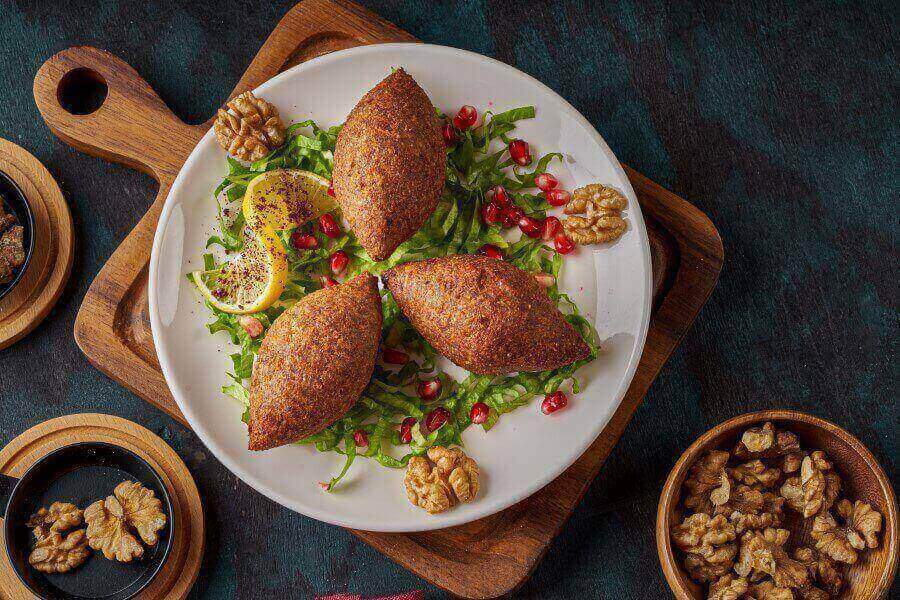
Quibe, a delightful dish that blends Middle Eastern influences with traditional Brazilian food, is a perfect example of the power of simplicity in Brazilian cuisine.
Made with a mixture of ground meat (typically beef), bulgur wheat, onions, and spices, Quibe is shaped into oval or elongated forms before being either fried or baked to perfection. It can be enjoyed as a savory snack or a satisfying main course. The presence of Quibe in Brazil is connected to the Lebanese and Syrian immigrants who arrived in the country during the late 19th and early 20th centuries.
With them, they brought their culinary heritage, including the beloved Quibe, which quickly found its place among the Brazilian people. Today, Quibe is a versatile and flavorful dish, found in street food stalls and shared at family gatherings, adding a touch of Middle Eastern flair to Brazilian cuisine.
The Best Traditional Vegetarian Food In Brazil
Açaí Bowl

Açaí, a beloved representative of foods from Brazil, has captured the hearts and taste buds of people worldwide. This superfruit, native to the Amazon rainforest, has garnered immense popularity for its refreshing and nutritious qualities. In Brazil, açaí is commonly relished in the form of an açaí bowl.
The bowl consists of açaí pulp topped with a variety of toppings like granola, sliced fruits, and a drizzle of honey. For centuries, indigenous tribes of the Amazon have recognized açaí as a staple food, appreciating its unique taste and remarkable health benefits. In recent years, the popularity of açaí has soared, transcending borders and captivating taste buds internationally.
Açaí bowls have emerged as a favored choice for breakfast or a revitalizing snack, presenting a harmonious fusion of flavors and providing a burst of energy. This luscious bowl exemplifies the essence of traditional Brazilian food and reflects the captivating diversity of Brazilian cuisine.
Pão de Queijo (Cheesy Rolls)

Pão de Queijo is an integral part of traditional Brazilian food. Hailing from the state of Minas Gerais, these delightful cheese bread rolls have garnered immense popularity both within the country and beyond. Crafted with a unique blend of cassava flour and cheese, Pão de Queijo boasts a chewy texture and a delectable cheesy flavor.
Its roots can be traced back to the indigenous peoples of Brazil, who had already been making similar bread using cassava. In the 18th century, as Minas Gerais thrived as a hub for gold mining, African slaves and Portuguese settlers exchanged culinary knowledge, leading to the evolution of Pão de Queijo into its current form.
Since then, it has become a cherished snack and breakfast item, serving as a beloved representation of Brazilian cuisine.
Farofa (Traditional Cassava Side Dish)
Farofa, an essential part of Brazilian cuisine and foods from Brazil, is a toasted cassava flour mixture that adds a delightful crunch and flavor to meals.
It is commonly served as a side dish, complementing a wide variety of dishes. Farofa has its origins deeply rooted in the indigenous cuisine of Brazil, where cassava was a staple crop. Indigenous communities would dry and grind cassava roots into flour, which was then toasted to enhance its taste and texture. With the arrival of Portuguese colonizers, farofa underwent further adaptations, embracing new ingredients and seasonings to create a unique blend of flavors.
Today, farofa has evolved into a versatile and beloved accompaniment, offering a crunchy and savory element to Brazilian food. Whether paired with feijoada, grilled meats, or other traditional dishes, farofa adds a distinct touch to the culinary tapestry of Brazil, reflecting the country’s rich traditions.
Canjica (Coconut Porridge Pudding)
Canjica, also known as mugunzá, is a delightful sweet porridge that showcases the heartwarming essence of traditional Brazilian food.
Made from white corn kernels simmered with milk, sugar, cinnamon, and an array of aromatic spices, canjica is a beloved dish particularly enjoyed during Festa Junina, a festive celebration in Brazil that pays homage to the harvest season. The roots of canjica lie in the indigenous and African culinary traditions, where corn held great importance as a staple crop.
Through the centuries, canjica embraced influences from Portuguese colonizers, who introduced milk and spices to enrich the dish. Festa Junina, with its blend of European, indigenous, and African elements, became the perfect occasion to savor canjica, symbolizing the abundance, prosperity, and cultural diversity of Brazil.
The comforting and sweet flavors of canjica, coupled with its significance in traditional Brazilian foods and festivities, make it a cherished part of the country’s culinary tapestry, captivating taste buds and nurturing a sense of togetherness.
Rabanada (Brazilian “French Toast”)

Rabanada, a Brazilian twist on the classic French toast, is a delectable food in Brazil that has become synonymous with the Christmas season. The preparation involves soaking bread slices in a mixture of milk, eggs, sugar, and spices before frying them to a golden crispness.
Sprinkled with a generous amount of cinnamon sugar, Rabanada is served warm, offering a comforting and sweet indulgence. While its origins can be traced back to European cuisine, specifically Portuguese influences brought by the colonizers, Rabanada has evolved in Brazil to incorporate local ingredients and flavors.
It has found a special place in Christmas celebrations, evoking fond memories of joyous gatherings and creating a sense of nostalgia. Rabanada is a beloved dessert that adds a touch of sweetness to the festive season, reflecting the rich traditions and flavors of Brazilian cuisine.
Popular Traditional Food In Brazil: Desserts, Sweets, And Drinks
Brigadeiro (Brazilian “Cupcakes”)

Originating in the 1940s, these beloved Brazilian sweets have become synonymous with celebrations and gatherings throughout Brazil. Crafted from a delectable combination of condensed milk, cocoa powder, butter, and chocolate sprinkles, Brigadeiros are bite-sized chocolate fudge balls that captivate the taste buds.
The creation of Brigadeiro was a tribute to Brigadeiro Eduardo Gomes, an esteemed Brazilian Air Force officer, and influential political figure who fought for the presidency in 1945. Since its inception, Brigadeiro has enchanted both young and old, and its cherished recipe has been passed down from generation to generation, establishing itself as an indispensable element of Brazilian dessert culture.
Whether relished at joyous birthday parties or festive occasions, Brigadeiro exemplifies the irresistible allure and indelible charm of foods from Brazil.
Quindim (Coconut Custard Dessert)

Quindim, a delightful traditional Brazilian food, is a beloved dessert that has become a popular sweet treat in Brazil. It features a sweet custard made from a combination of egg yolks, sugar, butter, and shredded coconut, carefully baked to achieve a golden and firm texture. Introduced during the colonial period by Portuguese settlers, their custard-making techniques found a new home in Brazil.
The name “quindim” is believed to stem from the African Bantu word “kintiti,” which translates to “gold.” The vibrant yellow color and decadent flavor of Quindim perfectly capture its golden essence. Today, it holds a special place in Brazilian cuisine, particularly in the northeastern region, where it is often savored during festive occasions.
Brigadeirão (Brazilian Chocolate Cake)

Brigadeirão, a delectable and indulgent dessert, holds a special place in the realm of traditional Brazilian food. This creamy chocolate flan, crafted from condensed milk, cocoa powder, eggs, and butter, is a larger rendition of the beloved Brigadeiro sweet. Born from the rich history of Brigadeiro, which emerged in the 1940s as a tribute to Brigadeiro Eduardo Gomes, Brigadeirão has since evolved into a favorite dessert across Brazil.
As culinary enthusiasts experimented with the Brigadeiro recipe, Brigadeirão emerged as a larger and sliceable version of the sweet, perfect for serving during special occasions, parties, and celebrations.
The velvety texture and chocolatey richness make Brigadeirão an irresistible treat that embodies the essence of Brazilian cuisine and captivates dessert lovers far and wide.
Caipirinha (Brazil’s National Cocktail)

Caipirinha, the quintessential Brazilian cocktail, embodies the spirit and flavors of Brazil’s vibrant culinary landscape of food in Brazil. This refreshing and tangy libation, composed of cachaça (a sugarcane spirit), lime, sugar, and ice, has secured its place as Brazil’s national cocktail. Originating in the countryside regions where cachaça production flourished, Caipirinha emerged as a delightful showcase of this distinctively Brazilian spirit.
Traditionally enjoyed in its pure form or in simple mixed drinks, cachaça found new life with the addition of lime and sugar. The resulting Caipirinha, with its harmonious blend of flavors, captured the hearts of locals and visitors alike.
In 2003, it was officially designated as Brazil’s national cocktail, an accolade that highlights its cultural significance. Sipping on a Caipirinha transports one to the sun-kissed warmth of Brazil, evoking the joyous and carefree spirit of Brazilian cuisine and landscape.
Guarana (Traditional Brazilian Soft Drink)

Guarana, a beloved beverage in Brazil, holds a special place in the realm of traditional Brazilian food. This popular soft drink is derived from the seeds of the guarana plant, boasting a slightly sweet taste and a caffeine-rich profile that provides a natural energy boost. Indigenous communities of the Amazon region have cherished guarana for centuries, recognizing its invigorating properties.
The roots of guarana in Brazil can be traced back to the indigenous tribes of the Sateré-Mawé people, who employed guarana seeds to create a traditional beverage. As European influence reached Brazil, guarana gained wider acclaim and eventually found its place as a commercialized soft drink.
Today, guarana not only quenches thirst but also serves as a cultural symbol, representing the country’s profound connection to its natural resources, and stands as a testament to the diversity of foods from Brazil.
Tapioca (Traditional Brazilian Dessert)
Tapioca, a beloved street food in Brazil, epitomizes the essence and diversity of foods from Brazil. This popular treat is crafted from cassava starch, and cooked on a hot griddle to form a thin and flexible crepe-like base.
It is then filled with an array of sweet or savory ingredients, folded, and transformed into delightful gluten-free Brazilian snacks. Tapioca finds its origins in the indigenous cuisine of Brazil, where cassava was a staple food. Indigenous tribes skillfully extracted the starch from cassava roots, transforming it into a versatile ingredient.
Over time, tapioca gained widespread popularity throughout the country, particularly in the northeastern region, where it evolved into a cherished street food enjoyed by people of all ages. Today, tapioca delights the senses with a variety of fillings, ranging from cheese and coconut to chocolate and meat, encapsulating the diverse flavors and cultural influences that define Brazil’s culinary landscape.
Tapioca offers a taste of tradition and innovation in every bite.
Bolo De Rolo (Traditional Brazilian “Swiss Roll”)
Bolo de Rolo, a delicately rolled cake, is a delicious example of the artistry and delectable sweetness of traditional Brazilian desserts. Originating from the state of Pernambuco, this unique confection features thin layers of cake meticulously rolled with a luscious guava paste filling.
The cake batter is spread thinly, baked to perfection, then rolled and sliced into mesmerizing spiral patterns, creating an enticing visual display and a burst of flavors. The roots of Bolo de Rolo can be traced back to the Portuguese sponge cake brought by colonizers to Brazil.
The result is a cake that captivates the senses with its delicate layers, delightful sweetness, and the distinct touch of guava. Bolo de Rolo has earned its place as an iconic dessert in Pernambuco, often gracing special occasions and serving as a delightful accompaniment to a cup of coffee. It is a true testament to the creativity and mastery found in traditional Brazilian cuisine.
Cachaça (Famous Brazilian Drink)

Cachaça, an iconic spirit deeply ingrained in the fabric of Brazilian cuisine, showcases the rich history and vibrant flavors of foods from Brazil. Made from sugarcane juice and resembling rum, cachaça is a versatile beverage used in a variety of cocktails, most notably the famous Caipirinha.
Its origins can be traced back to the sugarcane plantations of the colonial era, where enslaved individuals and plantation workers discovered the art of fermenting and distilling sugarcane juice. The name “cachaça” derives from the Portuguese term for “sugarcane juice,” highlighting its close association with this beloved spirit.
Over time, cachaça has become deeply intertwined with Brazilian culture, serving as a symbol of celebration, joy, and the spirited nature of the nation’s culinary heritage. Today, cachaça is not only cherished domestically but also renowned globally, as it represents the vibrant and captivating flavors of Brazilian cuisine.
Food In Brazil: The Best Seafood Dishes
Moqueca (Traditional Fish Stew)
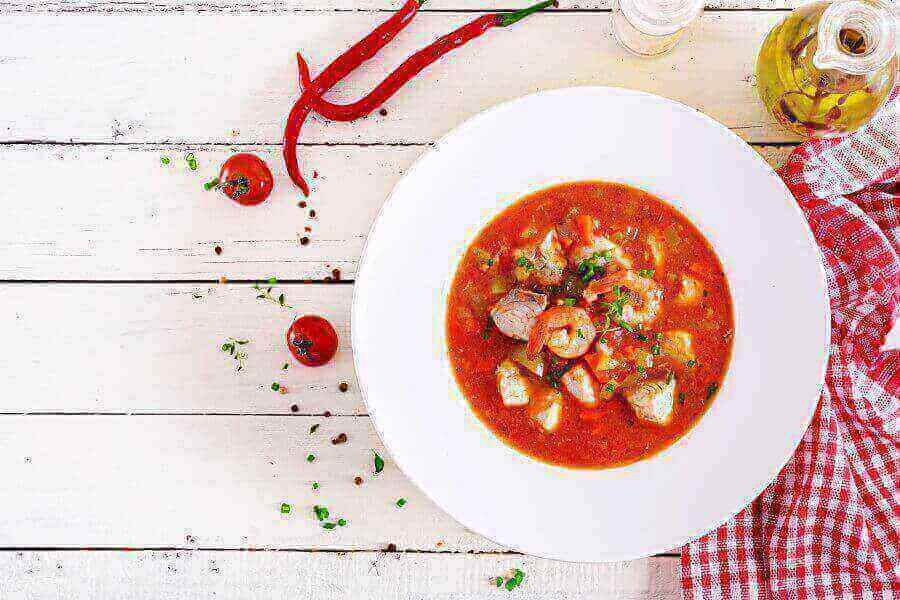
Moqueca, a staple in Brazilian cuisine, captures the essence of coastal flavors and cultural heritage. Originating from the coastal regions of Brazil, particularly Bahia and Espírito Santo, this traditional seafood stew is a culinary masterpiece. The base of Moqueca consists of fish or shrimp simmered in a fragrant broth infused with coconut milk, tomatoes, onions, garlic, and palm oil. This delectable dish embodies the fusion of indigenous, African, and Portuguese culinary traditions.
With the arrival of Portuguese colonizers in the 16th century, coconut milk and palm oil were introduced to food in Brazil, merging seamlessly with the abundance of fresh seafood in the region and giving birth to the fragrant Moqueca. Today, this beloved dish stands as a testament to the coastal heritage of Brazil, firmly establishing its place within the realm of traditional Brazilian food.
Bobó De Camarão (Traditional Shrimp Stew)
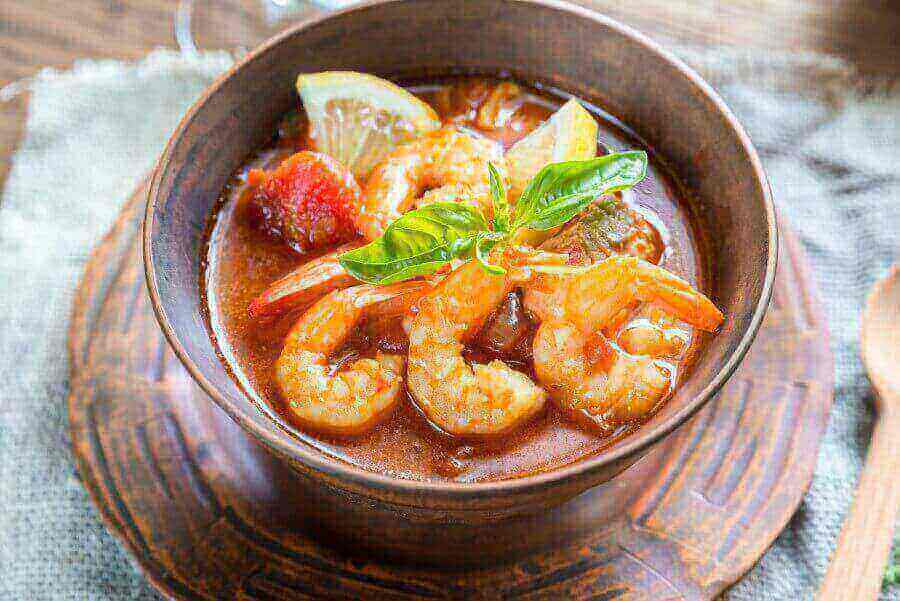
Bobó de Camarão, a traditional Brazilian food, showcases the vibrant flavors and cultural fusion found in food in Brazil. This creamy shrimp stew with African roots originates from the state of Bahia and combines a delightful blend of ingredients.
The dish features succulent shrimp, coconut milk, dendê oil (palm oil), onions, tomatoes, peppers, and an array of spices, resulting in a harmonious and comforting flavor profile. Bobó de Camarão is a reflection of the Afro-Brazilian culinary heritage, influenced by the cooking techniques and ingredients brought by enslaved Africans. The very name “bobó” stems from the African term “mbobô,” signifying a dish made with mashed yam or cassava.
Over time, the recipe has evolved in Bahia, incorporating local ingredients and flavors, to create this beloved and cherished dish. Bobó de Camarão stands as a shining example of traditional Brazilian food, encapsulating the diversity and richness of Bahian cuisine.
Vatapá (Coconut And Shrimp)
Vatapá, another gem among the foods of Brazil, is a captivating and flavorful dish deeply rooted in the culinary traditions of Bahia. This dish traces its heritage back to the cuisine of the Ketu people, an ethnic group hailing from West Africa.
Enslaved Africans brought their cooking techniques and ingredients to Brazil, shaping the culinary landscape of the country. Vatapá is a delectable blend of bread, shrimp, coconut milk, peanuts, palm oil, and an array of spices. This rich and flavorful mixture is commonly served as a side dish or used as a filling for Acarajé, a popular street food in Brazil.
The dish underwent further adaptations in Bahia, incorporating local ingredients and flavors, such as peanuts and palm oil.
Vatapá stands as a cherished staple of Bahian cuisine – celebrated for its complex and captivating flavors that pay homage to the African heritage of the region. It serves as a prime example of Brazilian cuisine.
Tacacá (Brazilian Shrimp Broth)
Tacacá, a traditional Amazonian soup, is a vibrant and unique traditional food of Brazil.
Originating from the indigenous tribes of Brazil, this unique soup is crafted from tucupi, a yellow broth extracted from manioc root, combined with shrimp, jambu leaves for a tingling mouth sensation, and a medley of spices. Tacacá is deeply intertwined with the culinary traditions of the Amazon region, where indigenous communities have been perfecting their preparation for centuries.
The diverse flavors and ingredients found in Tacacá are a reflection of the remarkable biodiversity of the Amazon rainforest, as well as the different foods of Brazil.
Beyond its culinary appeal, Tacacá holds profound cultural significance, often associated with social gatherings and festive celebrations in the region. This remarkable dish serves as a bridge between nature and food, showcasing the deep-rooted culinary heritage of the indigenous people of the Amazon and their harmonious relationship with the surrounding environment.
Casquinha de Siri (Brazilian Crab Appetizer)
Casquinha de Siri is a delectable appetizer highlighting the abundance of seafood in Brazil.
Made with crabmeat, onions, tomatoes, bell peppers, and a blend of spices, Casquinha de Siri is baked until it achieves a golden and crispy texture. Served in a crab shell, this dish is a culinary delight found in coastal regions throughout the country. Its roots can be traced back to Bahia, where it first gained popularity and eventually spread across Brazil.
The name “casquinha de siri,” meaning “little crab shell,” aptly describes its unique presentation. Casquinha de Siri has become a favored choice for seafood enthusiasts, providing a harmonious blend of flavors and textures that capture the essence of the ocean.
FLAVORS AROUND THE WORLD |
Celebrating The Richness Of Food In Brazil
Traditional Brazilian foods showcase the culinary prowess and diverse flavors of this cuisine. From Feijoada, the national dish made with black beans and various cuts of pork, to Brigadeiro, a beloved sweet treat made with condensed milk and chocolate, and Acarajé, a flavorful street food from Bahia, the foods of Brazil offer a delightful journey.
With influences from indigenous, African, European, and Middle Eastern cultures, traditional Brazilian food is a vibrant tapestry of flavors and traditions from all over the world. Whether you’re enjoying Feijoada at a local restaurant or savoring Brigadeiro while you explore famous Brazilian landmarks, these dishes epitomize the rich heritage and enticing tastes of Brazilian cuisine.
Interesting Influences On Brazilian Food
The Portuguese colonization left an indelible mark on food in Brazil. Portuguese settlers introduced ingredients like rice, wheat, and olive oil, as well as cooking methods such as baking and preserving meats. Feijoada, the iconic black bean stew with pork, is a prime example of the Portuguese influence on Brazilian culinary traditions.
Brazil’s cultural diversity owes much to waves of immigration from countries such as Italy, Germany, Lebanon, and Japan. These immigrant communities brought their own culinary traditions, which became interwoven with Brazilian cuisine. For instance, Italian immigrants introduced pasta dishes and contributed to the development of Brazilian-style pizza.
Today, traditional Brazilian foods continue to be celebrated and cherished, not only within the country but also across the globe. They serve as a testament to the cultural heritage, culinary artistry, and remarkable fusion of flavors that make Brazilian cuisine so unique.